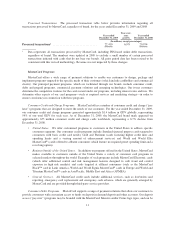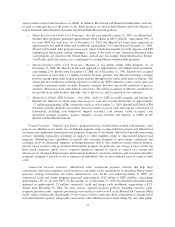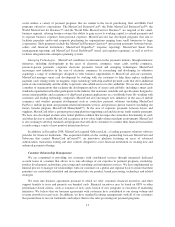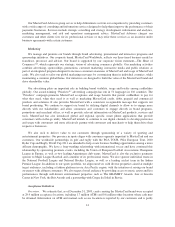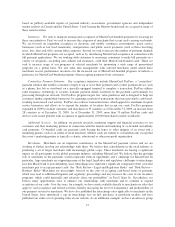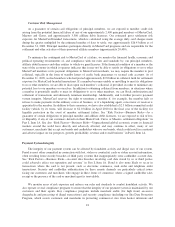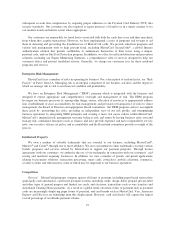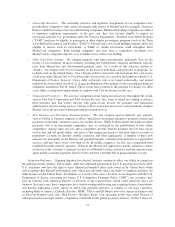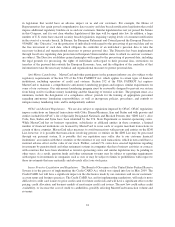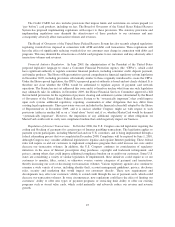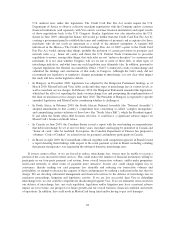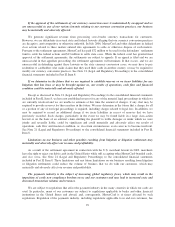MasterCard 2009 Annual Report Download - page 29
Download and view the complete annual report
Please find page 29 of the 2009 MasterCard annual report below. You can navigate through the pages in the report by either clicking on the pages listed below, or by using the keyword search tool below to find specific information within the annual report.subsequent account data compromises by requiring proper adherence to the Payment Card Industry (PCI) data
security standards). Our customers are also required to report instances of fraud to us in a timely manner so we
can monitor trends and initiate action where appropriate.
Our customers are responsible for fraud losses associated with both the cards they issue and their merchants
from whom they acquire transactions. However, we have implemented a series of programs and systems to aid
them in detecting and preventing the fraudulent use of MasterCard cards. We provide education programs and
various risk management tools to help prevent fraud, including MasterCard SecureCode®, a global Internet
authentication solution that permits cardholders to authenticate themselves to their issuer using a unique,
personal code, and our Site Data Protection program. In addition, we offer several fraud detection and prevention
solutions, including our Expert Monitoring Solutions, a comprehensive suite of services designed to help our
customers detect and prevent fraudulent activity. Generally, we charge our customers fees for these antifraud
programs and services.
Enterprise Risk Management
MasterCard faces a number of risks in operating its business. For a description of material risks, see “Risk
Factors” in Part I, Item 1A. Managing risk is an integral component of our business activities and the degree to
which we manage risk is vital to our financial condition and profitability.
We have an Enterprise Risk Management (“ERM”) program which is integrated with the business and
designed to ensure appropriate and comprehensive oversight and management of risk. The ERM program
leverages our business processes to, among other things, ensure: allocation of resources to appropriately address
risk; establishment of clear accountability for risk management; and provision of transparency of risks to senior
management, the Board of Directors and appropriate Board committees. Our ERM program seeks to accomplish
these goals by: monitoring key risks; providing an independent view of our risk profile; and strengthening
business operations by integrating ERM principles and creating a more risk aware culture within MasterCard.
MasterCard’s integrated risk management structure balances risk and return by having business units own and
manage risk, centralized functions (such as finance and law) provide expertise and have responsibility for key
risks, our executive officers set policy and accountability and the Board and committees provide oversight of the
process.
Intellectual Property
We own a number of valuable trademarks that are essential to our business, including MasterCard®,
Maestro®and Cirrus®, through one or more affiliates. We also own numerous other trademarks covering various
brands, programs and services offered by MasterCard to support our payment programs. Through license
agreements with our customers, we authorize the use of our trademarks in connection with our customers’ card
issuing and merchant acquiring businesses. In addition, we own a number of patents and patent applications
relating to payments solutions, transaction processing, smart cards, contactless, mobile, electronic commerce,
security systems and other matters, some of which may be important to our business operations.
Competition
General. MasterCard programs compete against all forms of payment, including paper-based transactions
(principally cash and checks), card-based payment systems, including credit, charge, debit, prepaid, private-label
and other types of general purpose and limited use cards, and electronic transactions such as wire transfers and
Automated Clearing House payments. As a result of a global trend, electronic forms of payment such as payment
cards are increasingly displacing paper forms of payment, and card brands such as MasterCard, Visa, American
Express and Discover are benefiting from this displacement. However, cash and checks still capture the largest
overall percentage of worldwide payment volume.
19




